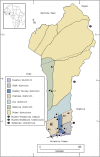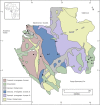Evidence of a link between taboos and sacrifices and resource scarcity of ritual plants
- PMID: 25573058
- PMCID: PMC4326513
- DOI: 10.1186/1746-4269-11-5
Evidence of a link between taboos and sacrifices and resource scarcity of ritual plants
Abstract
Background: One of the main obstacles for the mainstreaming of religious traditions as tools for the conservation of nature is the limited applicability of research results in this field. We documented two different restrictions implemented by local people (taboos and sacrifices) related to the use of ritual plants in Benin (West Africa) and Gabon (Central Africa).
Methods: To see whether these restrictions reflected plant scarcity from an etic perspective (official threat status) and an emic viewpoint (perceived scarcity by local people), we conducted 102 interviews with traditional healers and adepts of traditional faiths.
Results: We documented a total of 618 ritual plants, from which 52 species were used in both countries. In Benin, the use of 63 of the 414 ritual plant species was restricted; while in Gabon 23 of the 256 ritual plants were associated with taboos and sacrifices. In Benin, restricted plants were significantly more often officially threatened, perceived as scarce, and actively protected than non-restricted plants. In the more forested and less densely populated Gabon, plants that were perceived as scarce were more often associated to local restrictions than officially threatened species.
Conclusions: These results prove the presence of a form of adaptive management where restrictions are related to resource scarcity and protection of ritual plant species. By providing baseline data on possibly endangered species, we demonstrate how plant use in the context of religious traditions can yield important information for conservation planning.
Figures


Similar articles
-
Why ritual plant use has ethnopharmacological relevance.J Ethnopharmacol. 2016 Jul 21;188:48-56. doi: 10.1016/j.jep.2016.05.006. Epub 2016 May 5. J Ethnopharmacol. 2016. PMID: 27157629
-
The implications of ritual practices and ritual plant uses on nature conservation: a case study among the Naxi in Yunnan Province, Southwest China.J Ethnobiol Ethnomed. 2017 Oct 25;13(1):58. doi: 10.1186/s13002-017-0186-3. J Ethnobiol Ethnomed. 2017. PMID: 29065881 Free PMC article.
-
Ethnobotanical study on ritual plants used by Hani people in Yunnan, China.J Ethnobiol Ethnomed. 2024 Feb 13;20(1):17. doi: 10.1186/s13002-024-00659-y. J Ethnobiol Ethnomed. 2024. PMID: 38350958 Free PMC article.
-
Traditional uses of medicinal plants in gastrointestinal disorders in Nepal.J Ethnopharmacol. 2014 Dec 2;158 Pt A:221-9. doi: 10.1016/j.jep.2014.10.014. Epub 2014 Oct 18. J Ethnopharmacol. 2014. PMID: 25456430 Review.
-
Food taboos: their origins and purposes.J Ethnobiol Ethnomed. 2009 Jun 29;5:18. doi: 10.1186/1746-4269-5-18. J Ethnobiol Ethnomed. 2009. PMID: 19563636 Free PMC article. Review.
Cited by
-
Food beliefs and practices among the Kalenjin pregnant women in rural Uasin Gishu County, Kenya.J Ethnobiol Ethnomed. 2017 May 25;13(1):29. doi: 10.1186/s13002-017-0157-8. J Ethnobiol Ethnomed. 2017. PMID: 28545533 Free PMC article.
-
Local plant names reveal that enslaved Africans recognized substantial parts of the New World flora.Proc Natl Acad Sci U S A. 2014 Dec 16;111(50):E5346-53. doi: 10.1073/pnas.1418836111. Epub 2014 Dec 1. Proc Natl Acad Sci U S A. 2014. PMID: 25453066 Free PMC article.
-
Use Patterns, Knowledge Diversity and Drivers for the Cultivation of the Miracle Plant [Synsepalum dulcificum (Schumach & Thonn.) Daniell] in Benin and Ghana.Plants (Basel). 2021 Oct 22;10(11):2253. doi: 10.3390/plants10112253. Plants (Basel). 2021. PMID: 34834616 Free PMC article.
-
Commercialized "Smudge Sticks" Used as Incense in the Netherlands: An Inventory of Plants and Trends Behind a New Age Fashion.Plants (Basel). 2024 Oct 27;13(21):3003. doi: 10.3390/plants13213003. Plants (Basel). 2024. PMID: 39519920 Free PMC article.
-
A Narrative Review of Nutritional Malpractices, Motivational Drivers, and Consequences in Pregnant Women: Evidence from Recent Literature and Program Implications in Ethiopia.ScientificWorldJournal. 2021 Jun 19;2021:5580039. doi: 10.1155/2021/5580039. eCollection 2021. ScientificWorldJournal. 2021. PMID: 34248425 Free PMC article. Review.
References
-
- Berkes F. Religious Traditions and Biodiversity. Encyclopedia of Biodiversity. 2001;5:109–120. doi: 10.1006/rwbd.1999.0292. - DOI
-
- Kideghesho JR. The potentials of traditional African cultural practices in mitigating overexploitation of wildlife species and habitat loss: Experience of Tanzania. Int J Biodivers Sci Manage. 2009;5:83–94. doi: 10.1080/17451590903065579. - DOI
-
- Sasaki K, Sasaki Y, Fox ST. Endangered traditional beliefs in Japan: Influences on snake conservation. Herpetol Conserv Biol. 2010;5:474–485.
-
- Verschuuren B, Wild R, McNeely JA, Oviedo G. Sacred natural sites: Conserving nature and culture. Washington: Earthscan; 2010.
Publication types
MeSH terms
LinkOut - more resources
Full Text Sources
Other Literature Sources

